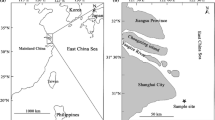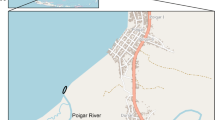Abstract
Glass eels migrating upstream in a New Zealand river showed a clear preference for water temperatures between 12 and 20°C, with an optimum of 16.5°C. Water temperatures <12°C and >22°C almost completely inhibited migration, which implies that warmer temperatures associated with global climate change might have a detrimental impact on glass eel recruitment in their current ranges. We established this by trapping glass eels of shortfin, Anguilla australis, and longfin, A. dieffenbachii, eels nightly from September to November. Eels caught in 2001 (50,287) outnumbered those caught in 2002 (19,954); shortfin glass eels dominated catches in both years, comprising 91–93% of the catch. Longfins were larger than shortfins, and size and pigmentation in both species increased as the seasons progressed. Temperatures within the migratory season in 2001 showed ∼14-day intervals between maxima that appeared to be associated with the new and full moons.






Similar content being viewed by others
References
Bannon HJ, Ling N (2004) Running the unseen, lowland gauntlet: compounding effects of temperature, hypoxia and exercise for diadromous fishes. In: Rupp GL, White MD (eds) Proceedings of the 7th international symposium on fish physiology, toxicology, and water quality, Tallinn, Estonia, 2004. U.S. Environmental Protection Agency, Ecosystems Research Division, Athens, Georgia, USA, EPA 600/R-04/049, pp 207–218
Barbin GP, Krueger WH (1994) Behaviour and swimming performance of elvers of the American eel, Anguilla rostrata, in an experimental flume. J Fish Biol 45:111–121
Bovee KD, Milhous R (1978) Hydraulic simulation in instream flow studies: theory and techniques. Fish and Wildlife Service, U.S. Department of the Interior
Chen YL, Chen H-Y (1991) Temperature selections of Anguilla japonica (L.) elvers, and their implications for migration. Austr J Mar Freshwater Res 42:743–750
Chisnall BL, Jellyman DJ, Bonnett ML, Sykes JRE (2002) Spatial and temporal variability in length of glass eels (Anguilla spp.) in New Zealand. NZ J Mar Freshwater Res 36:89–104
Ciccotti E, Ricci T, Scardi M, Fresi E, Cataudella S (1995) Intraseasonal characterization of glass eel migration in the river Tiber: space and time dynamics. J Fish Biol 47:248–255
Domingos IM (1992) Fluctuation of glass eel migration in the Mondego estuary (Portugal) in 1988 and 1989. Irish Fish Invest Ser A (Freshwater) 36:23–24
Dou S-Z, Tsukamoto K (2003) Observations on the nocturnal activity and feeding behavior of Anguilla japonica glass eels under laboratory conditions. Environ Biol Fish 67:389–395
Dutil JD, Michaud M, Giroux A (1989) Seasonal and diel patterns of stream invasion by American eels (Anguilla rostrata) in the northern Gulf of St. Lawrence. Can J Zool 67:182–188
Edeline E, Lambert P, Rigaud C, Elie P (2006) Effects of body condition and water temperature on Anguilla Anguilla glass eel migratory behavior. J Exp Mar Biol Ecol 331:217–225
Helfman GS, Bozeman EL, Brothers EB (1984) Size, age, and sex of American eels in a Georgia river. Trans Am Fish Soc 113:132–141
Hunt von Herbing I (2002) Effects of temperature on larval fish swimming performance: the importance of physics to physiology. J Fish Biol 61:865–876
Jellyman DJ (1977) Invasion of a New Zealand freshwater stream by glass-eels of two Anguilla spp. NZ J Mar Freshwater Res 11:193–209
Jellyman DJ (1979) Upstream migration of glass eels (Anguilla spp.) in the Waikato River. NZ J Mar Freshwater Res 13:13–22
Jellyman DJ (1987) Review of the marine life history of Australasian temperate species of Anguilla. Am Fish Soc Symp 1:286–297
Jellyman DJ, Lambert PW (2003) Factors affecting recruitment of glass eels into the Grey River, New Zealand. J Fish Biol 63:1067–1079
Jellyman DJ, Ryan CM (1983) Seasonal migration of elvers (Anguilla spp) into Lake Pounui, New Zealand, 1974–1978. NZ J Mar Freshwater Res 17:1–15
Jellyman DJ, Todd PR (1982) New Zealand freshwater eels: their biology and fishery. Fisheries Research Division Information leaflet No. 11. N.Z. Min. Agriculture and Fisheries, Wellington
Jellyman DJ, Tsukamoto K (2002) First use of archival transmitters to track migrating freshwater eels Anguilla dieffenbachii at sea. Mar Ecol Prog Ser 233:207–215
Jellyman DJ, Tsukamoto K (2005) Swimming depths of offshore migrating longfin eels Anguilla dieffenbachii. Mar Ecol Prog Ser 286:261–267
Jellyman DJ, Chisnall BL, Bonnett ML, Sykes JRE (1999) Seasonal arrival patterns of juvenile freshwater eels (Anguilla spp.) in New Zealand. NZ J Mar Freshwater Res 33:249–262
Jellyman DJ, Chisnall BL, Sykes JRE, Bonnett ML (2002) Variability in spatial and temporal abundance of glass eels (Anguilla spp.) in New Zealand. NZ J Mar Freshwater Res 36:511–517
Jessop BM (2003) Annual variability in the effect of water temperature, discharge, and tidal stage on the migration of American eel elvers from estuary to river. In: Dixon DA (ed) Biology, management, and protection of catadromous eels, Am Fish Soc Symp 33. American Fisheries Society, Bethesda, pp 3–16
Jowett IG, Richardson J (1994) Comparison of habitat use by fish in normal and flooded river conditions. NZ J Mar Freshwater Res 28:409–416
Kim WS, Yoon SJ, Moon HT, Lee TW (2002) Effects of water temperature changes on the endogenous and exogenous rhythms of oxygen consumption in glass eels Anguilla japonica. Mar Ecol Prog Ser 243:209–216
McCleave JD, Jellyman DJ (2002) Discrimination of New Zealand stream waters by glass eels of Anguilla australis and Anguilla dieffenbachii. J Fish Biol 61:785–800
McCleave JD, Kleckner RC, Castonguay M (1987) Reproductive sympatry of American and European eels and implications for migration and taxonomy. Am Fish Soc Symp 1:286–297
McDowall RM (2000) The Reed field guide to New Zealand freshwater fishes. Reed, Auckland
NIWA (2005) Tide forecaster (New Zealand). National Institute of Water and Atmosphere, Wellington. http://www.niwa.co.nz/services/tides/
Pease B, Silberschneider V, Walford T (2003) Upstream migration by glass eels of two Anguilla species in the Hacking River, New South Wales, Australia. In: Dixon DA (ed) Biology, management, and protection of catadromous eels, Am. Fish. Soc. Symp. 33. American Fisheries Society, Bethesda, pp 47–61
Silberschneider V, Pease BC, Booth DJ (2001) A novel artificial habitat collection device for studying resettlement patterns in anguillid glass eels. J Fish Biol 58:1359–1370
Sloane RD (1984) Invasion and upstream migration by glass-eels of Anguilla australis australis Richardson and A. reinhardtii Steindachner in Tasmanian freshwater streams. Austr J Mar Freshwater Res 35:47–59
Smith MW (1955) Control of eels in a lake by preventing entrance of the young. Can Fish Cult 17:13–17
Sorensen PW, Bianchini ML (1986) Environmental correlates of the freshwater migration of elvers of the American eel in a Rhode Island brook. Trans Am Fish Soc 115:258–268
Speed SR, Browne GN, Boyd RO (2001) Assessment and monitoring of commercial eel fisheries. Final research report Ministry of Fisheries Research Project EEL9801. Kingett Mitchell and Associates Ltd., Auckland
Strubberg A (1913) The metamorphosis of elvers as influenced by outward conditions. Meddelelser fra Kommissionen for Hevundersogelser 4:1–11
Sugeha HY, Arai T, Miller MJ, Limbong D, Tsukamoto K (2001) Inshore migration of the tropical eels Anguilla spp. recruiting to the Poigar River estuary on north Sulawesi Island. Mar Ecol Prog Ser 221:233–243
Tongiori P, Tosi L, Balsamo M (1986) Thermal preferences in upstream migrating glass eels of Anguilla anguilla (L.). J Fish Biol 28:501–510
White EM, Knights B (1997) Environmental factors affecting migration of the European eel in the Rivers Severn and Avon, England. J Fish Biol 50:1104–1116
Acknowledgements
This research was part of SMA’s M.Sc. study, and was approved by the Animal Ethics Committee of the University of Waikato (Protocol number 552). We acknowledge constructive criticism from Don Jellyman, NIWA, Christchurch, N.Z. Funding was provided by the N.Z. Foundation for Research, Science, and Technology Tūāpapa Pūtaiao Māori Fellowship, Te Ohu Kai Moana, and Ngāti Kahungunu Iwi Incorporated (NKII). We thank NKII, Analytical Research Laboratories, and Whakatu Industrial Park Technologies for the use of their equipment.
Author information
Authors and Affiliations
Corresponding author
Rights and permissions
About this article
Cite this article
August, S.M., Hicks, B.J. Water temperature and upstream migration of glass eels in New Zealand: implications of climate change. Environ Biol Fish 81, 195–205 (2008). https://doi.org/10.1007/s10641-007-9191-z
Received:
Accepted:
Published:
Issue Date:
DOI: https://doi.org/10.1007/s10641-007-9191-z




